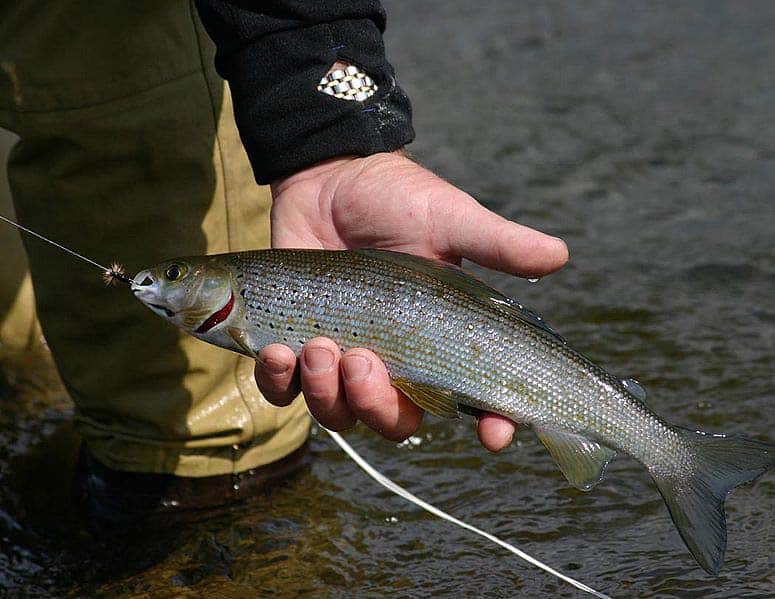You don’t have to be an avid fisherfolk to be amused and impressed by the adulation given to the Arctic grayling in various accounts of northern fish. Descriptions of this fish are as diverse and complimentary as “prince of Alaska sportfish,” “Alaska’s wilderness aristocrat,” and that its “regal grace and delicate personality” make it the symbol of the wild. The Latin name (Thymallus arcticus) was given to the grayling because fresh caught fish smell like the herb thyme. These elegant descriptions continue with regards to their physical features. Their large dorsal fin is dotted with large, brilliant red or bluish purple spots surrounded by a shade of emerald green which fades after death. On males, the dorsal fin sweeps as far back as the adipose fin, and females exhibit a shorter, more rounded fin. The pelvic fins are crossed by three pink stripes, and the belly is white with gray blotches. The tail fin is very forked and plain. There are scattered black spots, sometimes X-shaped, along the anterior portions of the sides. The various hues and colors will change with age and even a few bright yellow individuals have been seen. Arctic grayling are futher distinguished by a small mouth and an elongated trout-like appearance.
The grayling is intolerant of altered or polluted environments; it requires clear, cold streams and lakes in the most northern latitudes of the world. In Alaska, the grayling can be found in unsilted rivers that drain into the bering Sea and Arctic Ocean, as well as in most streams of the Interior, from north of the Brooks Range and as far south as the drainages of Cook Inlet. They can still be found all across northern Canada and in the northern latitudes of Eurasia but have become extinct in areas susceptible to pollution or disturbance of their environment.
Until the 1930’s they were found in Michigan and in the upper Missouri drainage of Montana, now they are hatchery-cultured in those states and have been introduced into mountainous areas of Colorado, Utah and Vermont.

In early spring grayling begin to congregate at the mouths of clearwater streams and rivers just before breakup. In April or May, as soon as streams open, they migrate up as far as 100 miles from their wintering waters. Spawning takes place from mid-May to mid- June. Males establish spawning territory and will follow a female and court her with a display of the dorsal fin. The female will release eggs (4,700 plus per female) which the male covers with milt over a sandy gravel bottom. The eggs are adhesive and stick to the substrate and other bottom structures. Depending upon the water temperature, the eggs hatch in two to three weeks. The young, which have been described as resembling “two eyeballs on a thread,” begin feeding the third or fourth day after hatching. Growth is fairly rapid the first year, with the young averaging about 4 inches long by September. Afterward, the growth rate is slow, taking four or five growing seasons to mature. Generally, growth rate is faster in the south than in the north. A 12-inch fish is probably 6-7 years old. The oldest grayling checked in Alaska was in its 11th year.
After spawning, the adults move to a more or less permanent summer residence (usually upstream) in pools. Territoriality and a social hierarchy develop quickly in each pool, with the largest and strongest fish occupying the most advantageous positions near the head of the pool, the smaller, subordinate fish farther downstream and the smallest of all occupying the foot of the pool without any territories.
Grayling will leave their summering streams in late fall before freezeup and migrate to the larger, deeper lakes and rivers, many of which are glacially fed. In summer, when there is a lot of glacial melt due to warmer temperatures, these same streams and rivers are too heavily laden with silt. However, with the onset of freezing temperatures, the melting stops and the waters quickly clear up, allowing grayling to safely overwinter there.
Studies have revealed that Alaska’s grayling seldom feed on fish, and about 65% of all material ingested in early summer consisted of aerial insects (mosquitoes!). They also feed on many aquatic forms of insects and on terrestrial species which accidentally fall in the water. Several summers ago while on a backpacking trip with my son, we caught an unusually large grayling while flyfishing. Our curiosity about its large size prompted us to see what it had in its stomach. After finding three partially digested shrews, I had a hard time enticing Jeffrey to partake in the main course of our evening meal!
The Arctic grayling is one of the most important sport fishes of Alaska and northern Canada. It is also an important component to subsistence fishing in some remote areas. While not a spectacular fighter, “the delicate attack of a hooked grayling is unmatched by many game species, as it leaps gracefully and gives a worthy account right up to the landing net.”
With all these lovely accolades, the purist angler can put on a fly (anything that looks like a mosquito) and enjoy another Alaskan “trophy” or simply go out and share the wonderful domain of the “sailfish of the north.”



